In our How to Paint Everything series, we take a look at different armies of the Warhammer universes, examine their history and heraldry, and look at several different methods for painting them. Today Evan “Felime” Siefring is talking about how to paint the Garden of Morr, or the Sigmarite Mausoleum as it’s sometimes known. Also Beanith grabbed onto any excuse to not paint his horde of Beast Snagga boys.
Evan “Felime” Siefring’s Mottled Stone and Verdegris.
In light of recent events, the original title “How to Paint Everything: Spooky Graveyards” seemed a touch too on the nose. I think the official trademarkable GW names will do nicely. In this article I’m going to go over how I painted my Sigmarite Mausoleum, as well as how you should paint yours. (Not necessarily exactly the same process. Please learn from my mistakes.) I will be using an airbrush, but it’s in no way necessary, just extremely convenient.
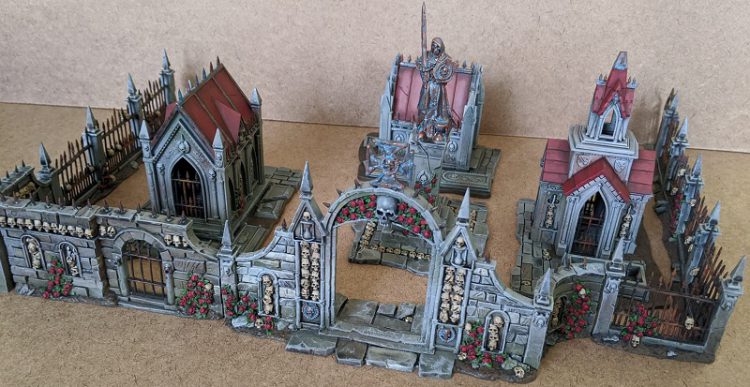
Step 0: Learn from my mistakes
So, I would have saved myself an hour or three of painstaking work if I’d done things in a different order. The first thing I would have done differently (after priming black) is painting the roofs first. Airbrush them solid red, then fade to black or brown to taste along the grooves and edges. Doing this carefully by hand once everything else is done is a huge pain. Speaking of things that are a huge pain to do carefully by hand, now also paint the railings and similar bits in the mausoleum doors. Airbrush any bits you probably accidentally sprayed red with black or brown leftover from fading the edges of the roofs. Then paint them normally as per the section below.
Once those are both painted, quickly varnish them, allow to dry thoroughly, and mask off with masking tape. I’ll tell you when to remove it in the main tutorial.
This is not a mistake I made, but until you’re done painting do not glue the buildings or any inconvenient bits, such as the main gates or sarcophagus covers you intend to leave half open.
Step 1: Mottled Stonework
Now, we’re into what is what I found to be the most fun, interesting, and rewarding part of this project. I was inspired by terrain builders, who often wash raw plaster with various colors, then apply a unifying black wash and drybrush to bring it all together. I wanted to emulate that depth of color on plastic terrain using an airbrush instead of washes.
First I primed everything black, then airbrushed everything with a splotchy, uneven coat of Vallejo Grey Surface Primer. Feel free to use whatever airbrush ready grey pleases you (Corrode: or any other colour – these are the Mortal Realms after all!), I just have a big bottle of grey primer ready to go, and the color works quite well.
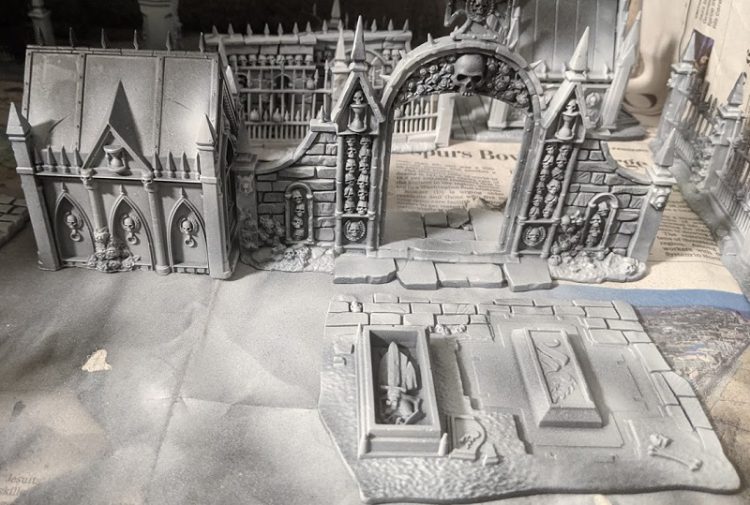
Next I went through and applied some mottled splotches of VMA Sand(Ivory) to start to add a little bit of variety in color to the stonework:
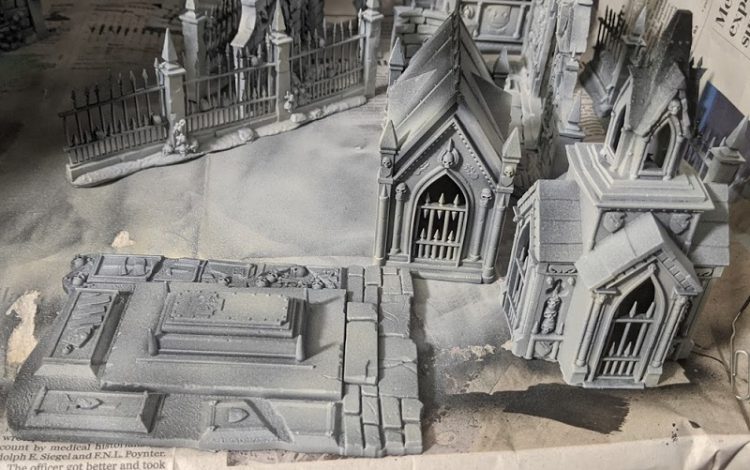
Then I did the same with VMA Burnt Umber. I concentrated this a little on the undersides of ledges and on the bottoms of walls and buildings where more dirt would accumulate, letting this color do triple duty as stone color, dirt, and shading.
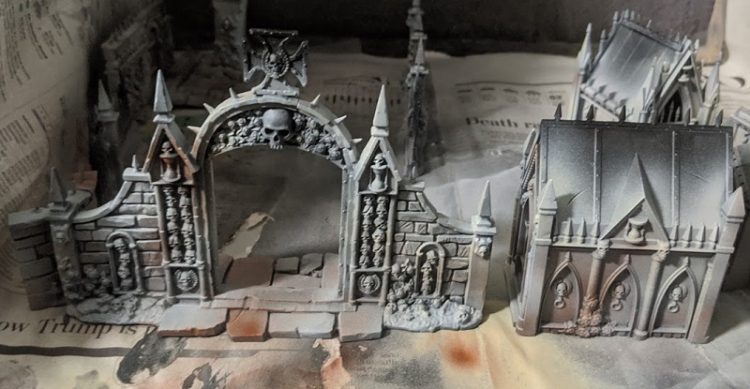
For the last color to add to the stone, I used VMA Medium Olive. I concentrated this color along the bottoms, under ledges, and near the vines, where moss would likely grow the most.

Finally, I picked out a few random individual stones with a brush using Golden High Flow Acrylics Shading Grey, Golden High Flow Acrylics Sepia, and VMA Sand(Ivory). (The golden colors are art store paints. Just use watered down gray or brown paints that you have.) None of these paints gave a particularly solid coat, and some of them are essentially washes. A solid coat is not required, you’re just looking to differentiate the stones a little bit to make the walls look less monolithic.
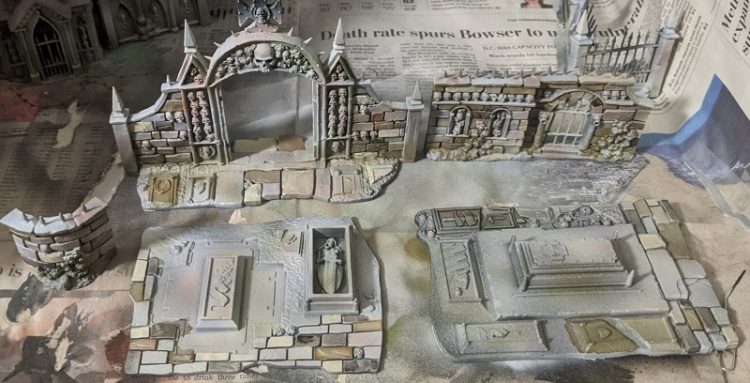
STEP 0 ALERT: Remove your masking now if you did things in a sensible order like I suggested in step 0. Soaking your masking tape in wash is not going to make it easier to remove, and you’re done with messy airbrushing now.
Now, you are going to need to hit everything with a black wash. I’d recommend whatever cheap mix you prefer, not using Nuln Oil. You’re going to use a whole bunch of this. My personal mix is Pledge Floor Care Finish (formerly Future Floor Polish), Black Craft Paint (Apple Barrel Specifically) and a little bit of water to fine tune the opacity. My wash mix is quite glossy, so I matte varnished everything afterwards. You may or may not need to do so depending on your mix.
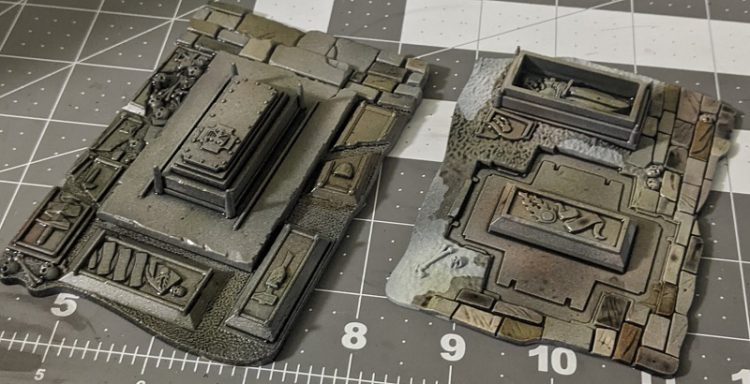
As you can see, the wash unifies the various colors you’ve laid down. To complete the effect, drybrush grey on top. You can use the grey you airbrushed with, but drybrushing airbrush paint is a pain, and I wanted to avoid having primer finish showing on the final product, so I used a mix of black and white craft paint(Apple Barrel.)
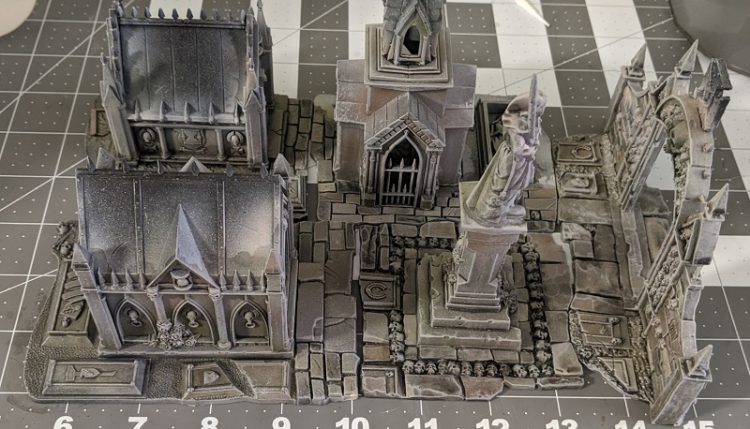
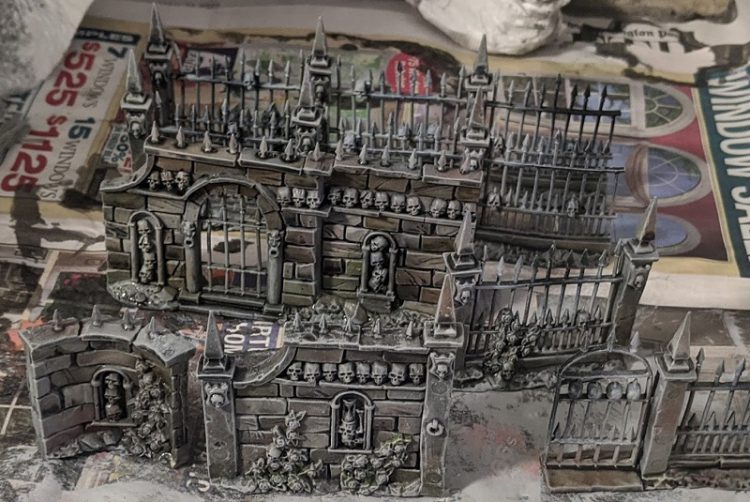
And your stone is done. You can apply this to any sort of stonework you want to paint. It’s pretty quick, easy and efficient, and provides a lot of visual interest compared to just flat black with a grey drybrush. Also feel free to experiment with various other colors. Purple, Yellow Ochres, Brick Reds, Dark Blues and Blue Greys would all look great with the right scheme.
NOTE TO NON AIRBRUSH HAVERS: To replicate this without an airbrush, take a cheap craft brush, get a little bit more paint on it than you would drybrush, and stipple the mottling patterns onto the stone. Expect this to take longer than using an airbrush, and destroy your craft brush. A bit of messiness doesn’t matter all that much, as the wash and drybrush afterwards will cover up myriad sins.
Step 2: Railings
STEP 0 ALERT: If you’re smart, do this first and mask it off before doing the stone. It will save you a lot of headaches, because carefully doing the edges of all of the railings with a brush SUCKS.
The railings were fairly simple. I painted them black, faintly drybrushed with very dark grey (I forget which, probably Skavenblight Dinge), then I stippled on patches of VMC Cavalry Brown, VMC Flat Earth, and VGC Orange Fire. I wanted to emulate wrought iron with patches of rust, and keep the railings quite dark to contrast with the stonework.
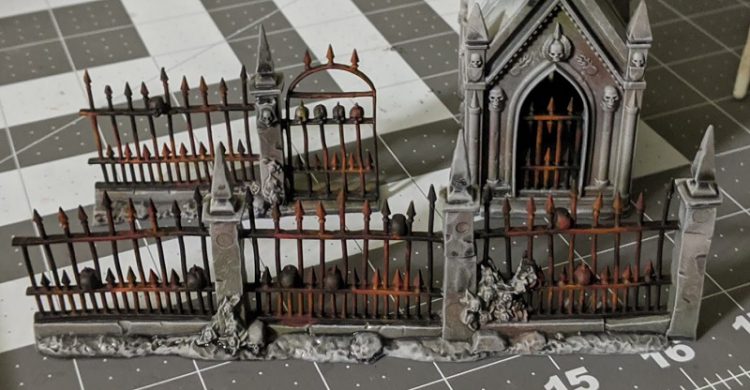
Step 3: Roofs
STEP 0 ALERT: I made things a lot harder than I had to with these. Airbrushing a fade, then masking off before doing the stonework would have been far, far easier, and I recommend you do the same.
So, for my roofs, I was originally going to do them a teal verdigris color. I quickly slapped some paint on them to see how they’d look, and I hated it, so I quickly pivoted to red. Because I am an idiot and did the stone before I did the roofs, I couldn’t just airbrush them red to get a nice smooth coat, so I improvised. First I painted them with VGC Heavy Red. As red it wont to do, the coverage was patchy, and my brushwork was showing in the finish. Instead of doing a whole bunch of coats, I instead airbrushed the center of each roof panel with VMA Red, avoiding the stone and edges. This hid all the ugly brushwork and evened up the coverage well.

Now, we’re moving onto somewhat more esoteric supplies. If you do this a sensible way you won’t need to do this, but in order to get a nice grimy look, I broke out some Windsor and Newton Burnt Umber oil paint. I thinned it slightly with odorless thinner, just enough it paints on like too-thick mini paint, and painted it along the edges and into the cracks on the roofs. If you follow in my footsteps, use a brush you don’t care much about and clean it well with soap and water afterwards.

Then, clean your brush off on a paper towel, and feather out the oil paint to fade into the grimy edges.
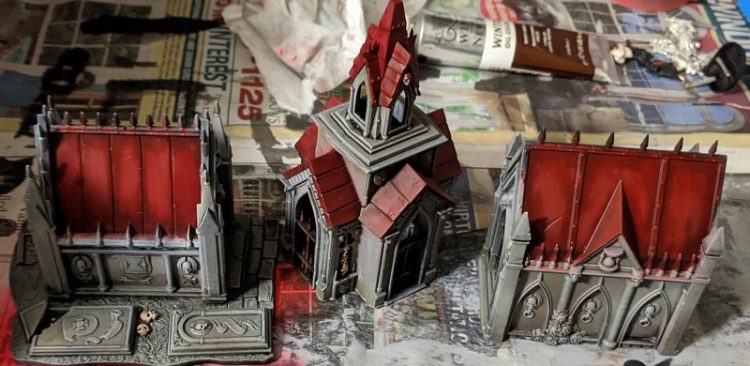
Ta-Da. Done. Now stick it somewhere where dust and cat hair can’t get to it for at least 24 hours. Preferably more. I’d suggest painting the skulls on the pieces without roofs at this point so that your hatred for these grows to a level where you don’t want to touch them for at least 3 days.
Step 4: Copper/Verdigris
I strongly encourage you to experiment with Verdigris and your own materials. I didn’t have any Nihilakh Oxide, or I probably would have used some of that. I will present the method I ended up using, though, as a rough template and reference.
First. Paint the copper parts copper. I used VMC Hammered Copper because I love that color and use it at every opportunity.
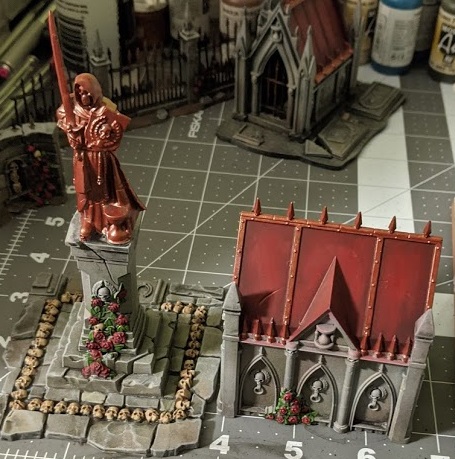
Then, wash it with brown to give it some age and a base shade for the areas without verdigris. I used watered down Golden High Flow Acrylics Sepia, which is pretty much the same thing as Agrax Earthshade.
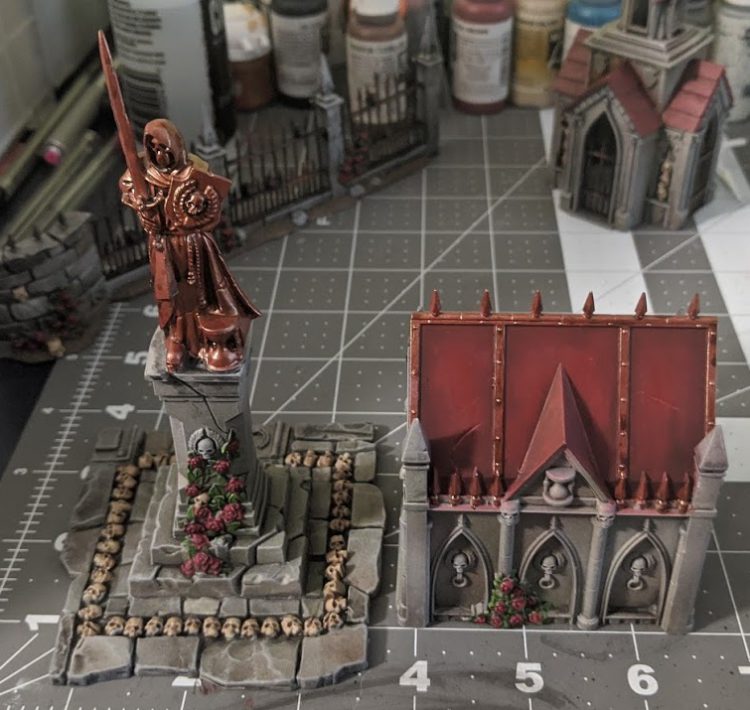
Then, using watered down VMC Turqoise I applied a splotchy, uneven wash/glaze. Play around with this. Apply too much and wipe some off with your finger or blot it up with the corner of a paper towel. It takes some fiddling to get things worked to a point that looks good.
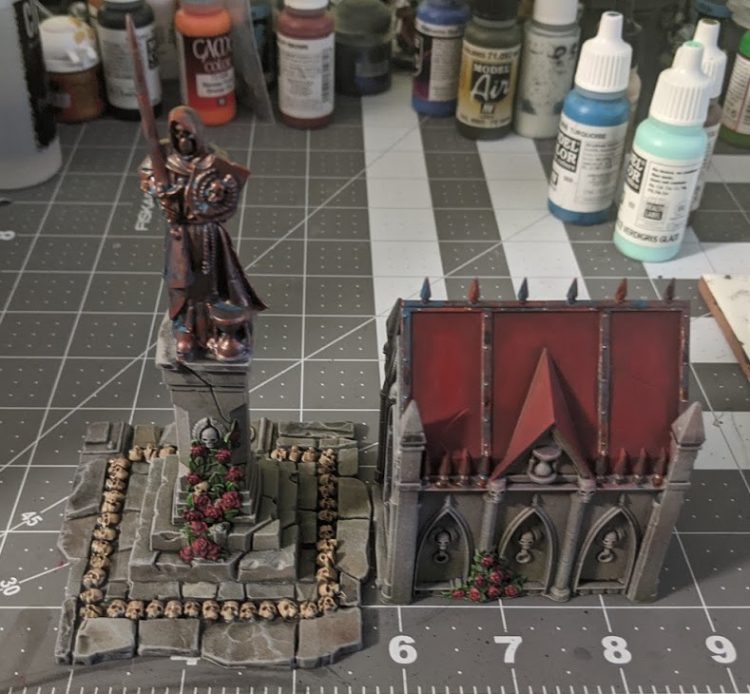
Then, I used VMC Verdigris Glaze to apply another layer of splotchy wash. This paint is very chalky and easy to push around. It took a lot of getting used to and playing around, but I eventually managed to work this into something I liked. I tried to concentrate the lighter colors into the recesses and get a good gradient, while still leaving enough copper showing that the effect didn’t become all teal all the time.

I want to experiment further with verdigris effect, and think I have more to learn. What I do really like about this is the two tone effect. It looks quite natural to my eye, and gives a lot of visual interest to the copper. I will probably pick up some Nihilakh Oxide at some point to play around with and possibly replace the Verdigris glaze with.
Step 5: Details, Some Pretty Roses and FAR, FAR Too Many Skulls
While this is step 5, you can do the little details at any point after you’ve done the railings and stone. There are WAY too many skulls on this model. You have to paint them carefully so you don’t get bone color on your finished stonework, and you have to paint them twice, because you really do need two thin coats to get solid coverage. For my skulls(and various random bones), I painted them with VMA Sand(Ivory), then washed with Agrax Earthshade. For your sanity, I recommend a similarly simple approach. The skulls are the worst part of painting this kit.
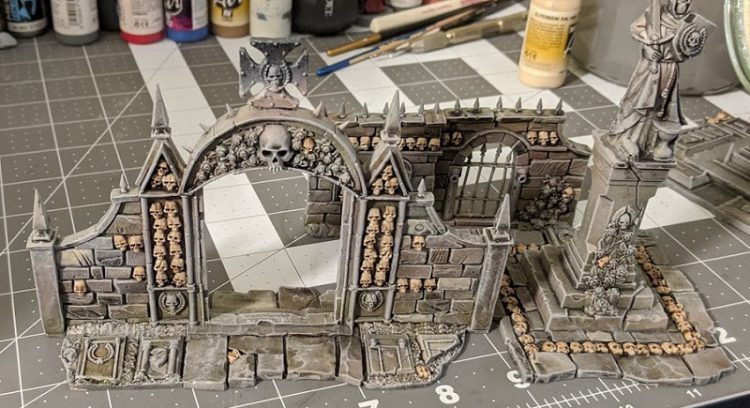
I LOVE the roses on this model. They really tie everything together, and doing them was one of my favorite parts. I painted the leaves first with VGA Goblin Green then painted the roses themselves with VMC Flat Red. Then I washed both the leaves and flowers with Nuln oil.

The only remaining details are the dirt and the little skeleton in the open sarcophagus. Paint the skeleton’s bones as you did the skulls. I then did the hilt and helmet in the same verdigris copper as the rest of the model, and the sword with a similar technique to the railings, just with a base of a dark iron color washed with nuln oil instead of black. The shield I just painted VMC Leather Brown and washed with Agrax Earthshade. I was feeling a little frisky, so I painted little stripes with Gorthor Brown to give it a little wood grain effect, but that’s not at all necessary.
Paint(and possibly flock) the dirt to match your table. I painted it with VMC Leather Brown washed with Nuln Oil for a fairly neutral dark earth.
Step 6: Play With Your Cool New Toys
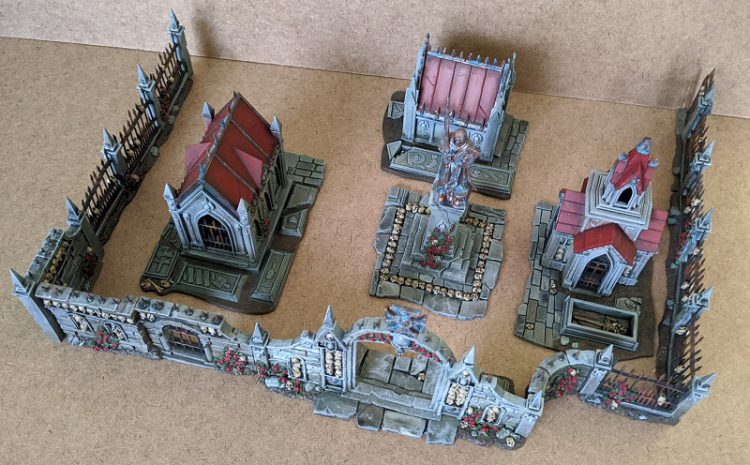
And you’re done! If you’re doing the whole Sigmarite Mausoleum set you’ll have a bit more than I have here. Either way, enjoy your newly spookified table!
Beanith’s faffing about last minute speed smoosh.
Step 1. Receive demands/request for pictures of Gardens of Morr from Rob with a 24 hour deadline.
Step 2. 10 hours later stop playing Satisfactory and realise you do own several sprues worth of Garden of Morr thanks to Mortal Realms and should probably help out.

Step 3. Prime everything black
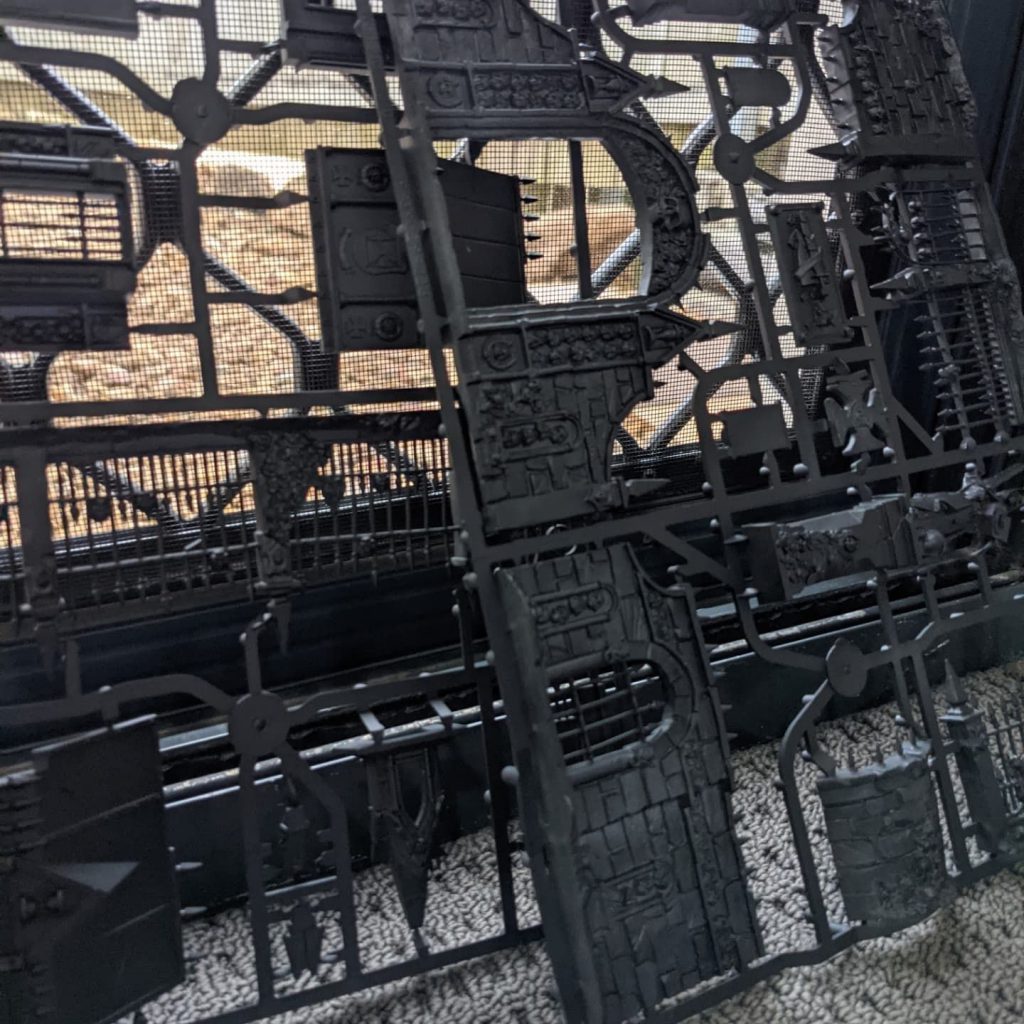
Step 3a. Swear loudly and profusely when you run out of Black undercoat two thirds of the way through.

Step 4. Soldier on like a trooper and start assembling.
Step 5. Come to the realisation that you’ve managed to miss an entire sprue, throw your hands in the air and take a long hard look at yourself.
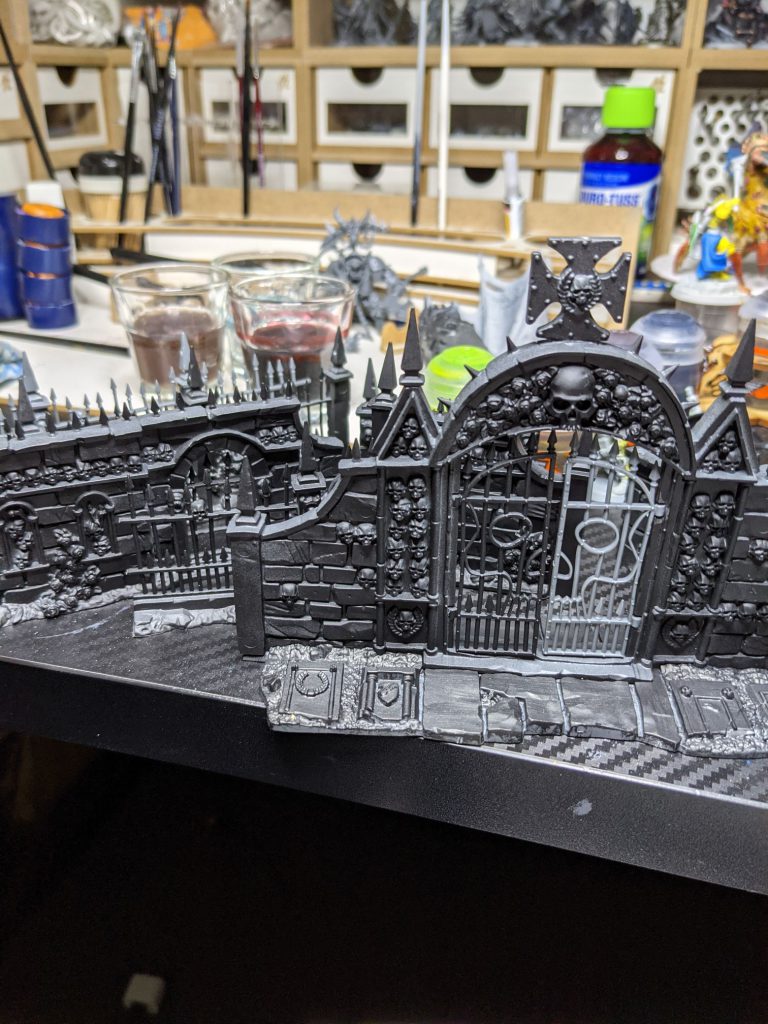
Step 6. Resist the siren call giving up and going back to Satisfactory and find a wall suitable to actually paint.

Step 7. Drybrush with a grey, in this case Warpaint’s D&D Ghoul Grey. Making sure to heavily drybrush the plants and skulls.
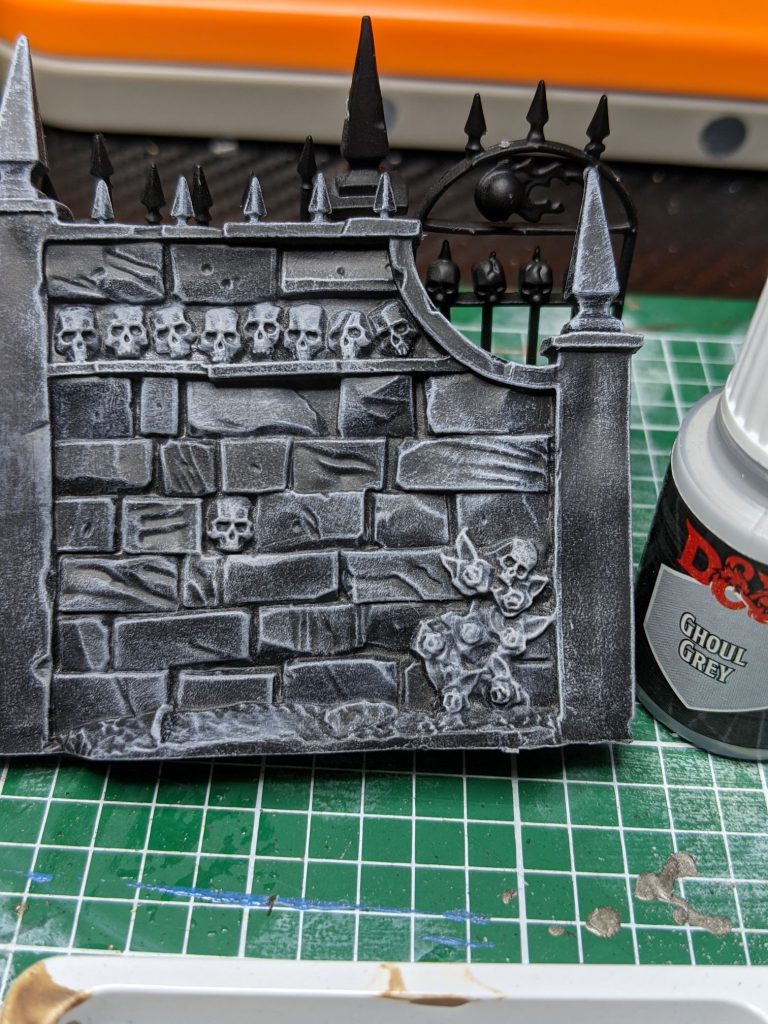
Step 8. Slap some Stirland Mud on the dirt.

Step 9. Smoosh the leaves with Contrast Dark Angels Green
Step 9a. Forget to take a photo
Step 10. Dot the flowers with Contrast Flesh Tearers Red

Step 11. Pick out those bones with Contrast Skeleton Hordes
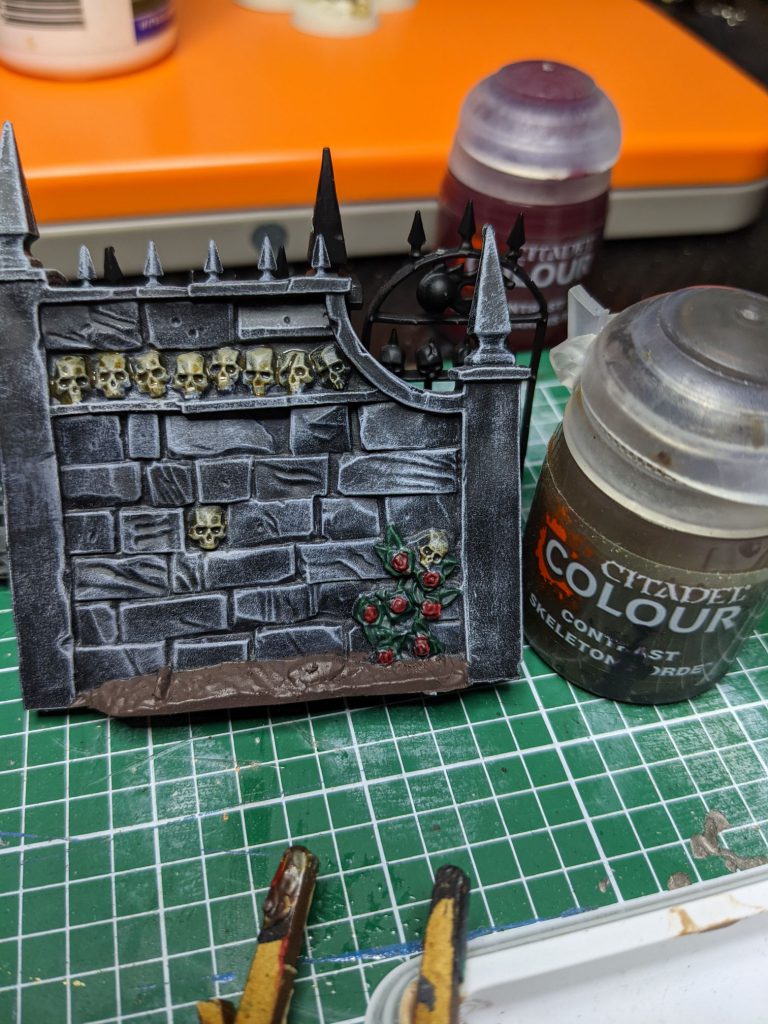
Step 12. Slip Agrax Earthshade into all of the crevasses, the cracks, plants and dirt.
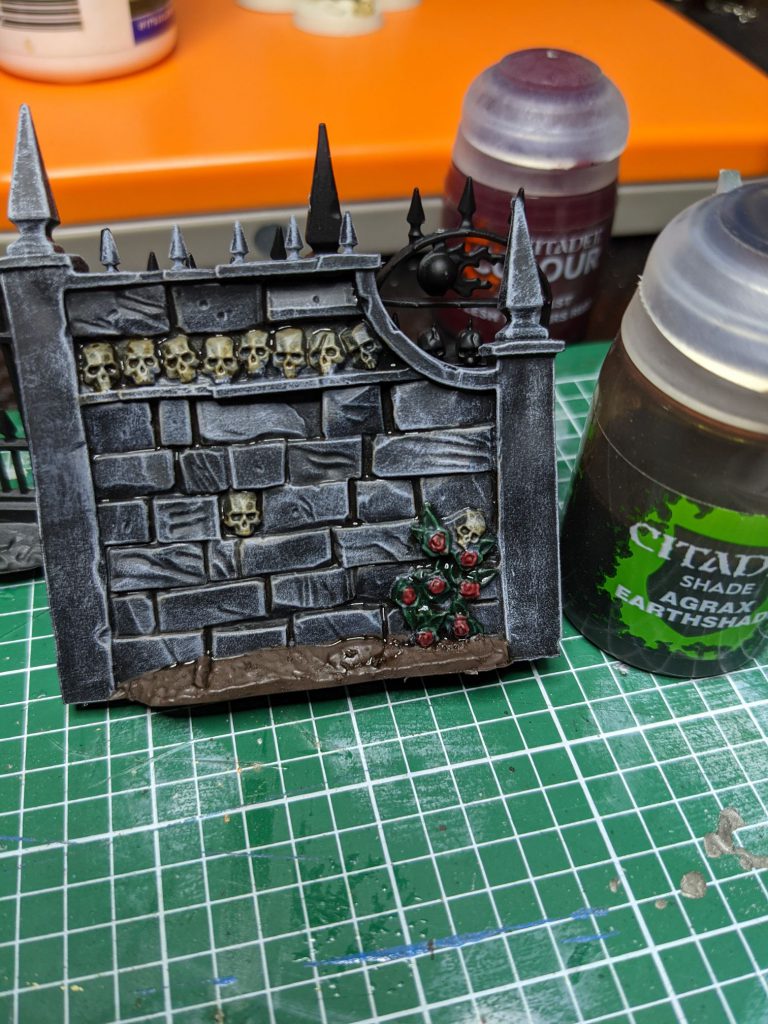
Step 13. Type this… and then wonder if Rob only needed photos…
Step 14. Swear loudly and profusely
Thanks Evan and Beanith! If you have any comments or feedback, or you just want to show us your own spooky terrain, then hit us up on Facebook, in the comments section, or email at contact@goonhammer.com.


